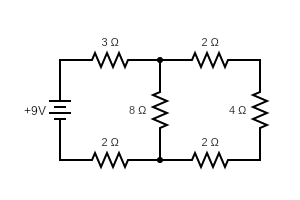In this article questions (multiple choice question, short answer type questions and numerical) from the chapter current electricity have been given with detailed answer. This chapter will help students of engineering degree or diploma courses. It is included in the first year physics course. Read all these questions for better understanding and grade in your course. This chapter includes current, resistance, series and parallel combination of resistances, Kirchhoff’s current law, Kirchhoff’s voltage law, wheat stone bridge, electrical energy etc.
Multiple choice questions (MCQs) on current electricity for first year physics of engineering courses
1. In the series combination of two or more than two resistances
a. The current through each resistance is same.
b. The voltage through each resistance is same.
c. Neither current nor voltage through each resistance is same.
d. Both current and voltage through each resistance are same
option a
2. The SI unit of power is
a. Joule
b. Newton
c. Watt
d. Ampere
option c
3. The resistance of a conductor varies inversely with
a. length of the conductor
b. area of cross-section
c. volume of the conductor
d. None of these
option b
4. The resistance of a conductor _________ with increase in temperature
a. decreases
b. increases
c. remains constant
d. first increases then decreases
option b
5. Three 15 Ω resistances are connected in parallel. What is the total resistance of this circuit
a. 15 Ω
b. 45 Ω
c. 0 Ω
d. 5 Ω
option d
The equivalent resistance of three resistances in parallel is
\frac{1}{R} = \frac{1}{R_{1}}+\frac{1}{R_{2}}+\frac{1}{R_{3}}
\frac{1}{R} = \frac{1}{15}+\frac{1}{15}+\frac{1}{15}
\frac{1}{R} = \frac{3}{15}
R=5Ω
6. In a conductor 8 coulomb of charge flows in 4 seconds. The value of electric current is
a. 8A
b. 12 A
c. 2 A
d. 0.5 A
option c
Current, I = Charge (q) / time (t)
I = 8/4 = 2 A
Numerical on Kirchoff’s current law and Kirchoff’s voltage law
1. Find the current through 4Ω resistance in the given circuit.

current= 0.5 A
2. Find the current through 1Ω resistance by applying Kirchhoff’s law in the following circuit.

current through 1 \Omega resistance is 0.13 A
Numerical on Equivalent resistance (current electricity) for engineering physics
1. Find the equivalent resistance between A and B

Resistance = 5 \Omega
2. What is the equivalent resistance between A and B

This is a wheatstone bridge circuit.
Here P = 3Ω, Q= 4Ω, R= 6Ω and S = 8 Ω
P/Q= 3/4 and R/S = 6/8 = 2/3
Therefore, P/Q = R/S
So, this is a balanced wheatstone bridge and the current through 7Ω resistor is zero.
So, the equivalent resistance of 3Ω and 4Ω is 3Ω+4Ω = 7Ω and
the equivalent resistance of 6Ω and 8Ω is 6Ω+8Ω = 14Ω
Now, the 7Ω and 14Ω resistances are in parallel, so the equivalent resistance of the circuit is
R_{ab}=\frac{7 \times 14}{7+14} = \frac{7 \times 14}{21} = \frac{14}{3} \Omega
3. Find the equivalent resistance between a and b

Equivalent resistance is r
4. Find the resistance between a and b

Equivalent resistance is 5r/8
5. What is the equivalent resistance of this circular loop between points a and b

Equivalent resistance is 4r/3
6. What is the equivalent resistance of this circular loop between points a and b of the following electrical circuit

Equivalent resistance is r/4
7. Find effective resistance between A and B of the given triangular circuit

Equivalent resistance is R
Short answer type question and answer on current electricity for engineering physics
1. State Ohm’s law.
This law states that the voltage across a conductor is directly proportional to the current flowing through it.
V\alpha I
V=RI
R is a proportional constant, called resistance
2. Write down the factors on which the resistance of a conductor depends.
R=\rho \frac{l}{A}
R is proportional to length l and inversely proportional to area of cross section, A
3. State Kirchhoff’s current law.
It states that the algebraic sum of all currents at any junction point of a circuit is zero.
4. State Kirchhoff’s voltage law.
It states that in a closed circuit the algebraic sum of the products of the current and resistance of each part of the circuit is equal to the total emf induced in the circuit.